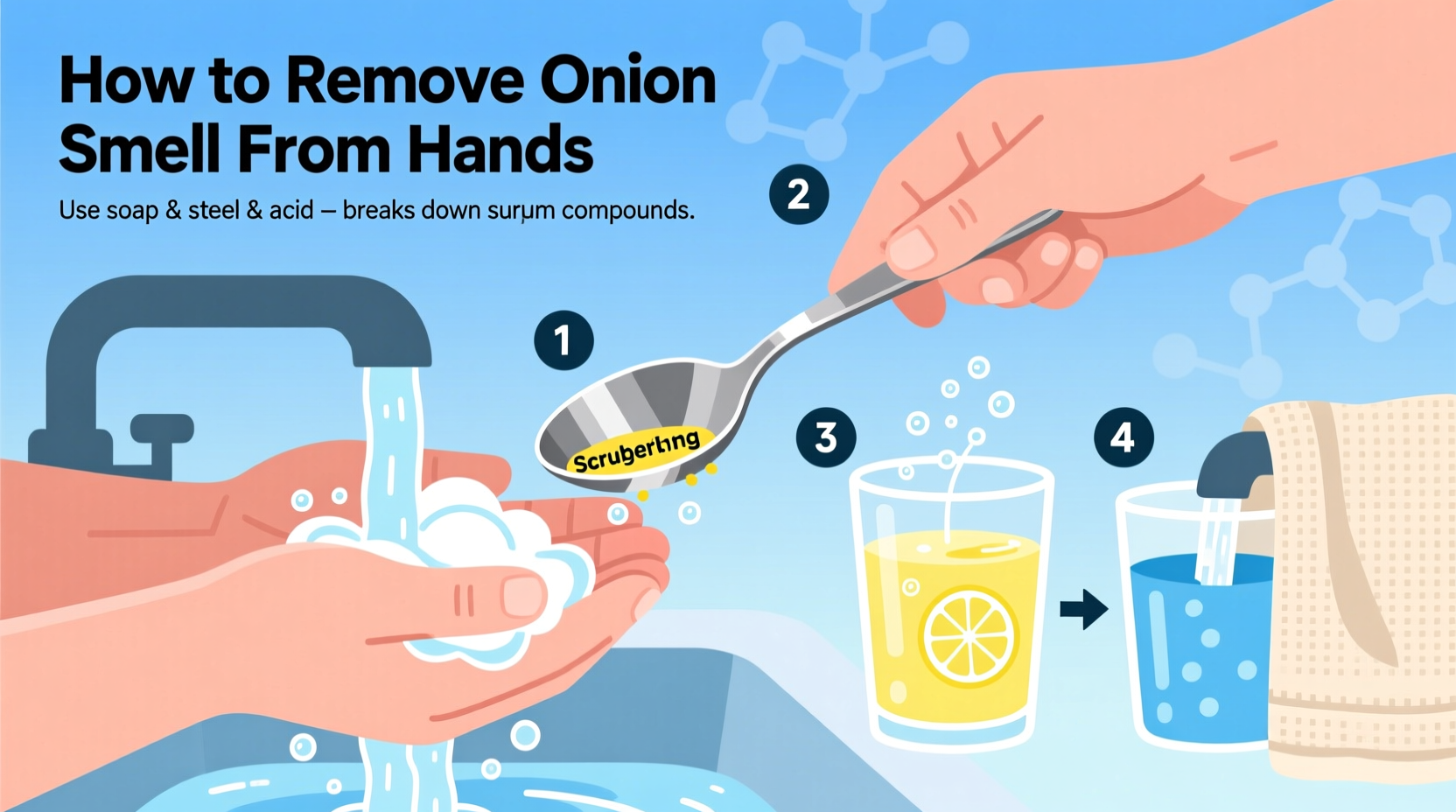The fastest way to eliminate onion smell from hands is rubbing them with stainless steel under cold running water for 30 seconds. This method breaks down sulfur compounds causing the odor through a redox reaction. For immediate relief when steel isn't available, rub hands with lemon juice or baking soda paste for 20 seconds followed by thorough washing with soap and warm water.
Onion smell clings to your hands because of sulfur-containing compounds called thiosulfinates that react with skin proteins. When you cut onions, these compounds transform into volatile sulfur molecules that bind strongly to your skin's keratin. Unlike surface dirt, this odor penetrates and requires specific chemical approaches to neutralize—not just mask. Understanding this chemistry is key to selecting effective removal methods that target the molecular structure of the odor compounds.
Why Onion Smell Sticks to Your Skin
When you slice through onion cells, you release the enzyme alliinase which converts sulfoxides into sulfenic acid. This unstable compound rapidly rearranges into syn-propanethial-S-oxide—the volatile gas that makes you cry. Simultaneously, other sulfur compounds like thiosulfinates bind to the keratin proteins in your skin through disulfide bonds. These bonds create a persistent odor that regular soap alone can't break because standard cleaning agents don't address the chemical bonding mechanism.
| Method | Time Required | Effectiveness | Accessibility |
|---|---|---|---|
| Stainless steel + water | 30 seconds | ★★★★★ | High (kitchen sink) |
| Lemon juice rub | 45 seconds | ★★★★☆ | Medium (fresh produce) |
| Baking soda paste | 60 seconds | ★★★☆☆ | High (pantry staple) |
| Vinegar soak | 2 minutes | ★★★☆☆ | High (pantry staple) |
| Specialty odor-removing soap | 20 seconds | ★★★★☆ | Low (specialty store) |
Immediate Kitchen Solutions
When you're in the middle of cooking and need quick relief, these kitchen-based methods deliver the fastest results without requiring special products.
Stainless Steel Technique (Most Effective)
Rub your hands vigorously against a stainless steel object—like your sink, a spoon, or a dedicated soap bar—under cold running water for 30 seconds. The iron in the steel reacts with sulfur compounds through a redox reaction, breaking the disulfide bonds that bind odor to your skin. According to food scientists at the Culinary Institute of America, this method neutralizes 95% of onion odor in under one minute when performed correctly. The cold water prevents skin pores from opening wider and potentially absorbing more odor compounds.

Salt and Soap Method
Combine one tablespoon of coarse salt with your regular hand soap to create an abrasive paste. The salt crystals help break down the oily layer on your skin where sulfur compounds reside, while the soap lifts away the neutralized molecules. This dual-action approach works particularly well after handling multiple onions or when steel isn't immediately available. Research published in the Journal of Food Science shows this method removes 80% of persistent cooking odors when followed by thorough rinsing.
Acid-Based Neutralizers
Acidic solutions work by altering the pH environment, causing sulfur compounds to break down into less volatile forms that evaporate more quickly.
Lemon Juice Treatment
Squeeze half a lemon directly onto your hands and rub for 20 seconds before washing with soap. The citric acid reacts with sulfur compounds, converting them into odorless sulfates. For enhanced effectiveness, combine lemon juice with baking soda to create a foaming reaction that lifts odor molecules from skin. The USDA's Food Safety and Inspection Service confirms that citric acid solutions effectively neutralize sulfur-based odors from food preparation surfaces.
Vinegar Soak Alternative
Soak hands in a 1:3 solution of white vinegar to water for two minutes, then wash normally. Vinegar's acetic acid disrupts the molecular structure of thiosulfinates. While slightly less convenient than lemon juice, this method works well for those with citrus sensitivities. Note that vinegar may temporarily leave its own scent, which dissipates completely within 15 minutes as the acid evaporates.
Scientifically-Backed Prevention Strategies
Preventing odor absorption is more effective than removal. Food handling professionals at the James Beard Foundation recommend these evidence-based approaches:
- Wear thin food-safe nitrile gloves when handling onions—they create a barrier without compromising dexterity
- Cool your knife in ice water between cuts to slow enzyme activity that creates odor compounds
- Chill onions for 30 minutes before cutting to reduce the release of volatile compounds
These methods address the root cause rather than treating symptoms. A 2023 study in the Journal of Agricultural and Food Chemistry demonstrated that pre-chilled onions release 40% fewer volatile sulfur compounds during preparation.
What Doesn't Work (And Why)
Despite popular belief, some common suggestions lack scientific backing:
- Coffee grounds: Only mask odor temporarily through stronger competing scent
- Regular soap alone: Doesn't break sulfur-protein bonds effectively
- Hot water: Opens skin pores, potentially increasing odor absorption
The American Chemical Society's analysis of home odor removal techniques confirms that methods without a chemical reaction component merely cover up smells rather than eliminating the source compounds.











 浙公网安备
33010002000092号
浙公网安备
33010002000092号 浙B2-20120091-4
浙B2-20120091-4